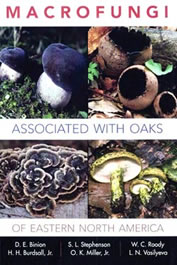

Macrofungi Associated with Oak Trees of Eastern North America has a host of authors well known to the mycological community. With a list of authors like this, you would expect the book to be good and it is. Macrofungi has a simple and very interesting approach: it is all about mushrooms associated with oak trees found in eastern North America. I previously have never seen a format like this, but it makes sense. Of course, some of the mushrooms are specific only to oaks, while others can also be found in association with other species of trees.
Macrofungi is divided into three sections: mycorrhizal, pathogens, and decomposers. There is at least one photograph with each species and to my personal joy, most of the pictures are on the left hand side of the page and the description on the right hand side, which makes the book very easy to use. Detailed descriptions and colored photographs are provided for 217 species. The taxonomic group, Latin name, common name, order, family, and synonym are listed. Likewise, a description of the fruiting body, cap or upper surface, spore-bearing surface, spore print color, spore size and description, occurrence and comments are included. Many common fungi are included, but some fairly rare ones are also described.
The book is 6 inches wide, 9 inches tall and 1 1/4 inches thick and has 467 pages. Macrofungi Associated with Oak Trees of Eastern North America provides an overview of the ecological relationships that exist between fungi and oak trees. Information is included on edibility, toxicity, medicinal properties and other novel uses. Also included are mushroom lookalikes, mushroom cultivation, and mushrooms that can be used as a source for natural dyes. The time year they are likely to be found is also included.
The photographs are a nice size, many being 3 1/2 by 5 inches or larger. That makes it better able to see the mushrooms and their fine details. Occasionally, the authors provide two or three pictures (e.g. with Omphalotus illudens, the Jack O’lantern mushroom). There is one picture of a cluster of Jack O’lanterns. Another picture shows the base of an oak tree with a number of clusters, which are a little older. Therefore, you get to see the mushroom in a very fresh state and another when it is much more mature. Both of these pictures are about 3 1/2 by 5 inches. Then on the opposite side where the description occurs, there is a small close up of the underside of the mushroom showing the sharp edged decurrent gills. The photographs are of very good quality. If I were to nitpick, I would suggest that on the photo pages that have only a single image, sometimes a second picture could have been added to the same page. Regardless, the pictures are large enough and good enough to stand on their own. In fact, all mycologists and mycophiles east of the Rocky Mountains will find Macrofungi Associated with Oak Trees of Eastern North America a tremendous asset when hitting the woods!
Besides the well-known authors, there are many names in the acknowledgement section of the book that you might also know. Michael Anderson, Genevieve Lewis-Gentry, Kitty Griffith, Martin Mackenzie, Hope Miller, Donna Mitchell, Donald Pfister, Walter Sturgeon, Alan Bessette, Randy Darrah, Tod Lewark, John Plischke III, and the Emily Johnson slide collection.
Review by John Plischke / Originally published in FUNGI Magazine - Volume 1, No. 4, Winter 2008
****************************************************************
simply close this document to return to the Cumberland Mycological Society web site
to return to previous menu